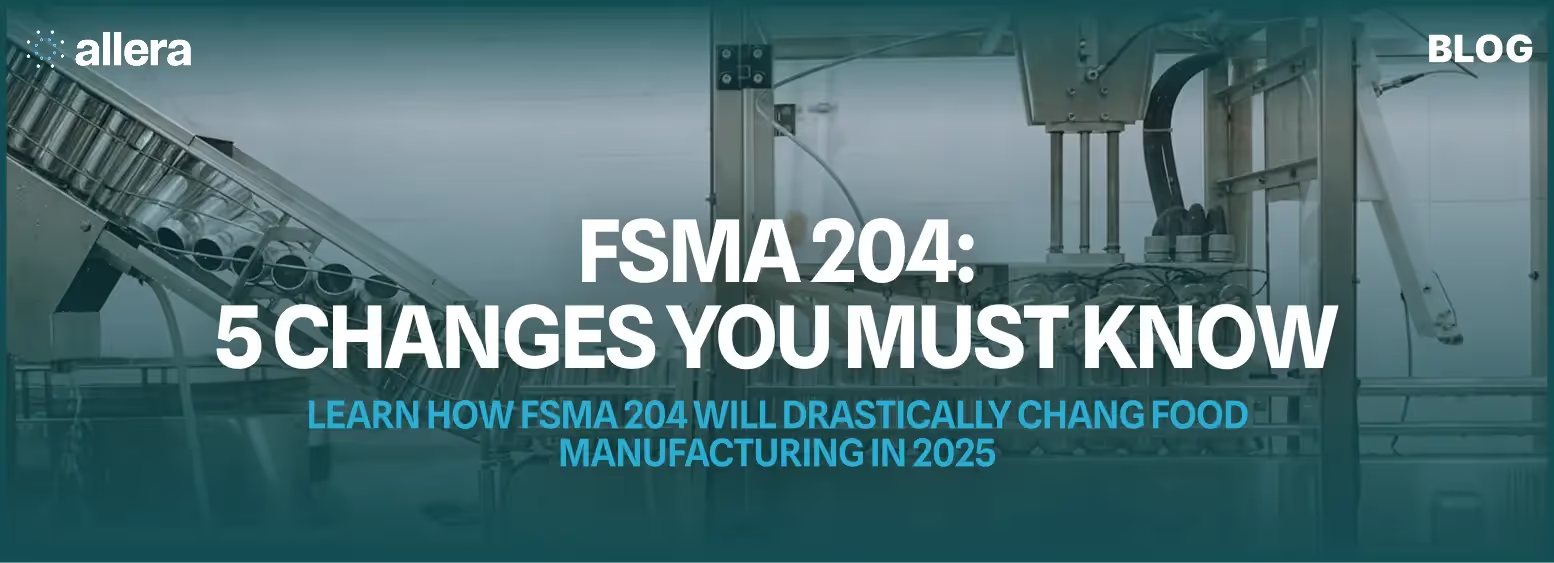

FSMA 204: 5 Changes You Must Know

Stop what you're doing–If your food manufacturing company handles any item on the FDA's Food Traceability List, the next five minutes could save you from regulatory nightmares, massive fines, and potential business closure.
FSMA 204's traceability rule includes five game-changing requirements that most food safety professionals are dangerously unprepared for.
While your competitors scramble in confusion, you can gain a decisive advantage. Keep reading to uncover the five FSMA 204 changes that industry insiders are already implementing—before they become mandatory for everyone else.
Key Takeaways:
- FSMA 204 amplifies food traceability obligations, especially for high-risk items.
- Preventive controls expand further, and you must verify them regularly.
- Import oversight intensifies, underscoring vendor verification methods.
- Training requirements now apply to businesses of every size and location.
- Staggered compliance dates give you phased timelines to integrate updates.
Know The FSMA 204 Context
FSMA 204 is a natural extension of the original FSMA framework, which aims to shift your approach from reacting to foodborne outbreaks to preventing them in the first place. Essentially, FSMA 204 refines existing rules, plugs gaps, and strengthens accountability. The rules apply to different points in the supply chain, whether you operate a local farm or manage an international supplier network.
The FDA took a global stance when crafting these changes, partnering with industry, academia, and other public agencies to shape compliance resources. This collaboration means you can rely on official training programs, such as the Produce Safety Alliance and the Food Safety Preventive Controls Alliance (FDA), to streamline your own strategy. If you have been following FSMA updates, you will likely recognize many of the same priorities—traceability, hazard analysis, and risk-based verification. But with FSMA 204, you will find new nuances designed to bolster preventive measures across a global supply chain.
Change 1: Mandate Food Traceability For Risky Products
Food traceability has been a focal point of FSMA from the start, but FSMA 204 raises the bar, especially if you handle high-risk foods like certain produce, seafood, or dairy products. Tracing ingredients from farm to fork becomes more comprehensive. You will need to keep meticulous records of a product’s journey, noting where it came from, who processed it, and where it is headed next. If an outbreak occurs, you should be able to pinpoint the source quickly and remove the affected batches from circulation.
Why Traceability Matters
Contaminated foods can spread pathogens rapidly if not traced in time. One study found that fast and accurate tracking can cut recall times significantly, helping you protect consumers and reduce legal liabilities. If your operation falls under the umbrella of high-risk foods, this new rule calls for a more robust food traceability plan, one that identifies core data elements—key pieces of information you need to record at each supply chain stage.
Key Steps To Improve Traceability
- Implement Digital Systems: Many businesses are migrating to cloud-based traceability software, which logs everything from farm IDs to shipping routes. This approach creates a centralized database for updates in real time.
- Minimize Manual Errors: Paper-based logs can be prone to inaccuracies. Where possible, automate data collection using barcodes or RFID tags.
- Conduct Regular Drills: Test your traceability system by simulating recalls. Aim to track a specific batch number from your facility to final distribution. Document how long it takes to achieve full trace-back.
- Partner With Suppliers: Collaborate closely with your suppliers to ensure they uphold consistent traceability protocols. A single weak link in your chain can undermine the entire process.
By embracing thorough traceability, you will find it vastly simpler to isolate problems before they escalate, making this first FSMA 204 mandate a crucial upgrade.
Change 2: Strengthen Preventive Controls For All Facilities
Next, FSMA 204 reaffirms and expands upon preventive controls, which are systematic safeguards used to identify and mitigate hazards in your operation. This expansion touches every corner of the industry, from small farms to large multinational processors. The new guidelines clarify that a written food safety plan, hazard analysis, and verified controls must be in place for each covered facility—a step defined in the Preventive Controls for Human Food (PCHF) rule.
Necessity Of Preventive Controls
Under FSMA 204, the goal is to ensure that you anticipate possible risks—from contamination in your supply area to cross-contact hazards during production. Once you identify these risks, you then apply measures like temperature control, allergen management, and food safety testing. The net effect should be a culture of prevention, not just a paper plan.
Critical Actions To Take
Update Your Food Safety Plan
If you have not revised your plan recently, now is the time. Your hazard analysis should consider new ingredients, suppliers, and processes. Clarify who handles each stage of your control measures.
Use Verification Activities
Product testing, environmental monitoring, and record checks all confirm that preventive controls do their job. If you identify a potential hazard—say, recurring microbial contamination—include steps to correct and verify its resolution.
Train Your Staff
Everyone should know not just how to follow control procedures, but why they are vital. Incorporate refreshers for new hires and long-term employees. Even a single misstep can lead to a widespread outbreak.
Keep Records Organized
Documentation will be the formal proof that you follow FSMA 204’s preventive controls. Use well-labeled logs and digital archives. If an FDA food inspector visits, thorough records simplify audits and reduce compliance headaches.
By reinforcing your hazard analysis and control plans, you align with FSMA 204’s directive to keep potential threats from scaling into major public health incidents.
If FSMA is forcing you to consider digitizing, we made a list of the top 10 best FSMA compliance software in 2025. It will guide will walk you through each tool covering the pricing, implementation time, certifications/standards/regulatiory support, and even provide an overall grade based on compliance, traceability, ease of use, scaleability, and support.
Change 3: Bolster Oversight Of Foreign Suppliers
You might rely on international vendors for raw materials and finished goods. With FSMA 204, the Foreign Supplier Verification Programs (FSVP) rule becomes even more integral. This rule mandates that you, as an importer, ensure your foreign suppliers meet U.S. safety standards. FSMA 204 not only spotlights the existing FSVP but also adds layers of expectation for thorough documentation and supervision.
How Global Suppliers Impact You
When contamination happens abroad, it eventually reaches your consumers. The idea behind FSMA’s expanded import oversight is to create a seamless global network of accountability, so no single step in the chain goes ignored. For instance, your foreign supplier must uphold the same preventive controls you practice, from hazard analysis to final verification.
Steps To Comply
- Verify Supplier Certifications: Some suppliers carry recognized credentials, such as a BRC audit. While FSMA 204 does not require specific certifications, it helps to partner with suppliers who have validated quality standards.
- Request Detailed Records: You should collect and review hazard analysis documents, test results, and any relevant certifications for each inbound shipment.
- Conduct Periodic On-Site Audits: Larger importers often opt for on-site audits to confirm that overseas facilities adhere to FSMA protocols. In some industries, remote or documentary audits are gaining popularity, but consider a physical visit if you suspect higher risks.
- Prepare For FDA Scrutiny: The FDA can ask for your verification records at any time. Make sure you store these documents systematically—just as you would for your domestic operations.
By integrating foreign suppliers into your preventive mindset, you ensure that your entire chain, from overseas harvests to U.S. store shelves, meets stringent FSMA 204 standards.
Change 4: Focus On Training And Outreach
A significant aspect of FSMA 204 is the emphasis on consistent, inclusive training programs for both large and small businesses worldwide. The FDA works with public and private partners to develop targeted training resources, making it easier for you to keep employees informed and confident in their roles. Whether you run a small orchard or a large processing plant, the training mandates aim to bridge knowledge gaps.
Why Training Matters Now More Than Ever
Under previous FSMA rules, training was recommended but often not uniformly applied. FSMA 204 places it front and center, recognizing that strong preventive controls mean little if workers do not understand how to follow them. You might even opt to enroll in specialized courses endorsed by the FDA or adopt a food quality management system that packages training, documentation, and process oversight in one framework.
Training Priorities
- Cover Core FSMA Elements: Teach your team about hazard analysis, recall procedures, and risk-based controls. Emphasize critical areas like sanitation, cross-contamination, and recordkeeping.
- Adapt Training To Roles: A packaging staffer may only need to know specific allergen risks, while a sanitation worker needs deeper training on cleaning protocols. Tailor modules so everyone gets the most relevant knowledge.
- Offer Ongoing Refreshers: Regulations evolve, and your operation might expand into new product lines. Work in annual or semi-annual courses to keep people alert. Good news—this is simpler than it sounds with the free resources available through the FDA’s alliances.
- Support Language And Cultural Needs: If you hire globally or work with international suppliers, consider language-friendly training materials. FSMA 204 encourages collaboration with local agencies to help you tailor outreach.
By investing in training, you cultivate a stronger safety culture, reduce turnover from confusion, and give employees a sense of ownership in your mission to protect consumers.
Change 5: Observe Staggered Compliance Deadlines
Finally, FSMA 204 continues the tradition of rolling out compliance dates based on business size. This approach aims to ease financial and managerial burdens, especially if you run a smaller operation. In many cases, large enterprises face the earliest deadlines, followed by medium-sized and then very small businesses.
Why Compliance Dates Matter
Recognizing that not every facility can switch gears overnight, the FDA offers staggered timelines. This strategy gives you room to plan, budget, and implement the necessary steps without shutting down production or interrupting sales. If you run a modest company, you likely have more time than a major multinational to make changes—but the rules will still apply. The FDA remains clear that public health protection is non-negotiable, and smaller firms are not exempt from essential preventive measures.
Creating A Compliance Roadmap
- Assess Your Business Size Category\The FDA’s definitions for large, small, and very small businesses inform your timeline. Check the official thresholds, typically based on annual sales or number of employees.
- Set Intermediate Milestones\Divide the transition into stages. Perhaps you start by updating hazard analyses in Quarter 1, then complete foreign supplier verifications by Quarter 3.
- Budget For Infrastructure\If you need new equipment for FSQA or updated sanitation lines, map out your spending so it does not all land at once. You might qualify for certain grants or financing aimed at food safety enhancements.
- Talk With Regulators\If you encounter challenges, engage with local extension offices or the FDA’s technical assistance programs. They exist to help you meet deadlines and keep food safe for consumers.
While these staggered deadlines may offer breathing room, do not let them lull you into complacency. Planning ahead ensures that you meet each milestone without scrambling.
Put These Changes Into Practice
FSMA 204 might feel like a heavy lift, but taking it step by step turns it into a practical roadmap for improvement. As you update traceability systems, bolster preventive controls, verify global suppliers, and train employees, you will create a safer environment for your customers. This approach is not just about meeting federal regulations. It is about building a sustainable food safety paradigm that your team feels motivated to maintain—including future hires and partners.
How To Combine The Changes
- Tailor your traceability plan to prioritize the highest-risk products first.
- Update your written hazard analysis, verifying your preventive controls with product testing and environmental checks.
- Collaborate with foreign partners to ensure consistent standards, especially if your supply chain crosses multiple borders.
- Develop training programs pegged to each role, and refresh them at intervals so everyone remains prepared for new FSMA updates.
- Lock in your compliance step by step using a timeline that acknowledges your current capacity and resources.
Integrating these five changes into your daily operations will fortify your commitment to food safety, making recalls less likely and protecting your brand reputation in the process.
Recap And Next Steps
- Reinvest In Traceability: Focus on high-risk items and implement clear, real-time records.
- Strengthen Preventive Controls: Write or revise your food safety plan and conduct frequent verification activities.
- Increase Foreign Oversight: Extend FSMA protocols to offshore suppliers and keep rigorous documentation.
- Expand Training: Equip staff with relevant, role-specific materials and encourage ongoing learning.
- Plan For Staggered Deadlines: Identify your business category and phase in changes to avoid last-minute pressure.
If you integrate these action items, you will position your operation for full compliance under FSMA 204. Along the way, you will also foster a robust safety culture that benefits employees and consumers alike. It is well worth the effort to implement these shifts now, rather than waiting until the last minute.
FAQs
How to comply with FSMA?
Compliance involves:- Developing a written food safety plan that includes hazard analysis and preventive controls.- Appointing a Preventive Controls Qualified Individual (PCQI) to oversee the plan.- Maintaining accurate records of monitoring, verification, and corrective actions.- Conducting supply chain verification for imported foods.- Training employees on food safety procedures.- Staying audit-ready with updated documentation and corrective action logs.Companies often use digital food safety management systems to streamline compliance and reporting.
Who is an Authorised person under FSMA?
This question may mix two contexts:In U.S. FSMA (Food Safety Modernization Act): An “authorized person” typically refers to FDA inspectors or officials granted authority to access facilities, review records, and enforce compliance.In UK FSMA (Financial Services and Markets Act): An “Authorised Person” is a financial services firm approved by the Financial Conduct Authority (FCA).For food safety, the U.S. FSMA context applies.
What does the FSMA stand for?
FSMA stands for the Food Safety Modernization Act, signed into U.S. law in 2011. It represents the most sweeping reform of U.S. food safety laws in over 70 years, shifting the focus from responding to contamination to preventing it.
Who needs FSMA?
Any facility that manufactures, processes, packs, or holds food for consumption in the United States must comply with FSMA (Food Safety Modernization Act) requirements. This applies to both domestic and foreign facilities exporting food into the U.S.
What are the 7 rules for FSMA compliance?
The seven foundational FSMA rules are:- Preventive Controls for Human Food- Preventive Controls for Animal Food- Produce Safety Rule- Foreign Supplier Verification Programs (FSVP)- Accredited Third-Party Certification- Sanitary Transportation of Human and Animal Food- Intentional Adulteration (Food Defense)
Who does FSMA apply to?
FSMA applies to most facilities involved in the U.S. food supply chain, including growers, processors, manufacturers, packers, distributors, and importers. Both U.S.-based and international businesses selling into the U.S. market must comply.
Who is exempt from registering under FSMA?
Exemptions apply to certain businesses, such as:- Farms that only grow and sell directly to consumers.- Small businesses under specific revenue thresholds (depending on the rule).- Facilities regulated exclusively by the USDA (e.g., meat, poultry, certain egg products).- Some low-risk food activities performed by small retailers or restaurants.
What is the best food safety certification?
The "best" certification depends on your industry and customer requirements. Common globally recognized standards include:SQF (Safe Quality Food): Widely used in North America, strong emphasis on traceability and continuous improvement.BRCGS (Brand Reputation through Compliance Global Standards): Popular among European and global retailers.FSSC 22000: Based on ISO standards, often preferred by multinational companies.HACCP: Foundational system required in many sectors and integrated into most other schemes.Ultimately, the best certification is the one your customers expect and that aligns with your operations.




.avif)


.avif)
.avif)

